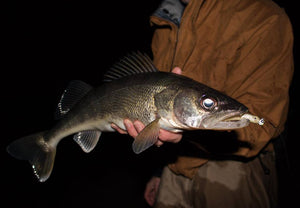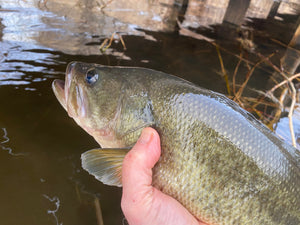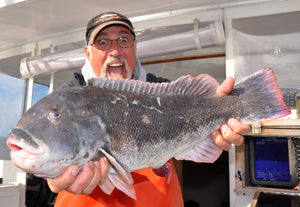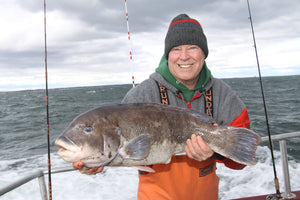Feather-weight Diamond Jigging in the Bays
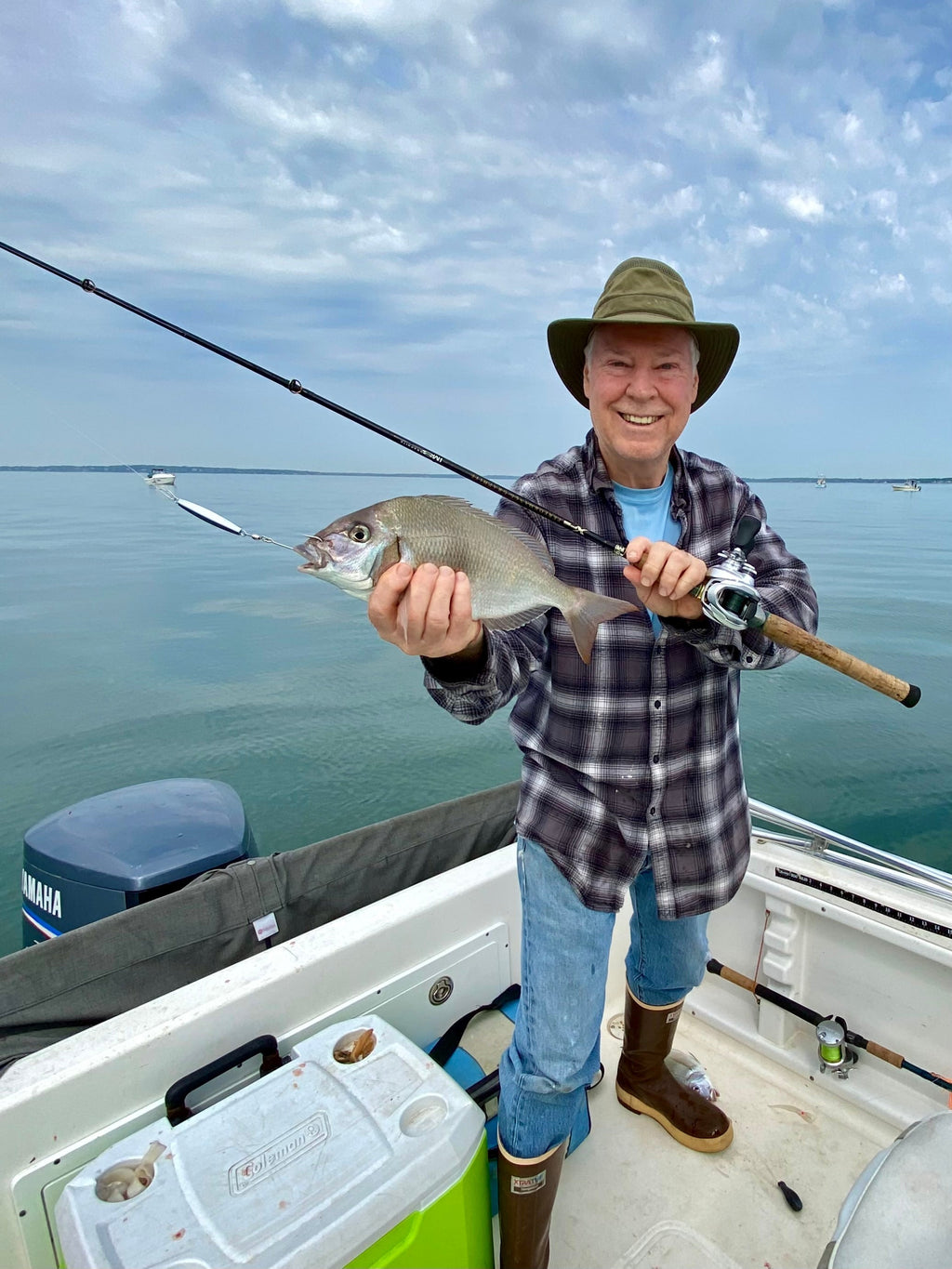
Just about anything will smack a small jig in the bays or in shallow waters on Long Island Sound. Jumbo porgies certainly are to be expected on September and early October trips. Photo by Felicia Scocozza.
As late summer struggles to hold on in Eastern Long Island and the fall season looms just ahead the waters of Peconic and Shinnecock bays, along with the stretch of Long Island Sound east of Mattituck Inlet, enters a transition period. With nighttime temperatures growing noticeably cooler in September, young of the year baitfish, spearing, snappers, baby weakfish and the like begin to spill from local tidal creeks and rivers out into more open waters.
Combined with the beginning transition from summer to fall species that may find anything from porgy, sea bass, fluke, kingfish, puffers and blues in local waters, this presents an opportunity for refreshed catches if you aren’t afraid to do a little prospecting. While serious bass and fluke fans are likely to continue running to the waters just inside Shinnecock Inlet, east of Plum Island and south of Montauk, you might be pleasantly surprised to find the variety and size of the fish you can pull not far from your dock or launch ramp at this time of year. With each passing week, in fact, the fishing is likely to improve - barring significant storms passing through which can sometimes halt the progress for a couple of days should the water become rough or discolored.
As we mentioned in our recent post on Peconic Bay’s Mixed-Bag Summer Action, all you really need to get in on this fun is a hi-low bottom rig with size #2 beak porgy hooks, some clam or squid strips for bait and a chum pot to really get things cooking. That’s fine if you want to anchor-up and enjoy some relaxing family fun. For those who have more of a roaming soul, however, feather-weight diamond jigging provides a completely different experience.
For this technique, you’ll be working a 10 – 12-pound class lightweight spinning or casting setup. We favor a 7-foot, medium-light Tsunami Carbon Shield 3 spinning rod matched to a Shimano Stradic 2500 reel loaded with 10-pound-test braided line. Tie on a three-foot length of fluorocarbon leader material with a Spro Prime Snap HD Lure Clip on the terminal end to allow for quick and easy lure changes so you can try different weights, profiles, sizes and brands.
As you’ll still be fishing in relatively tame bay and near-shore Sound waters, there’s no need to go heavy on the jigs. We’ve had success with standard tubeless diamonds ranging from 3/4 to 1.5 ounces, Hogy Epoxy Jigs from 5/8-ounce to 1.25 ounces, and Hogy Heavy Minnow Jigs weighing ½ to 1.25 ounces. Any of these should get you down to the bottom while also matching the size and profile of the spearing, sand eels and bay anchovies that are likely to make up the bulk of bay and Long Island Sound rainbait this time of year.
Now comes the easy part – the jigging process. As opposed to fall fishing for false albacore, blues and stripers when a moderate to quick retrieve usually scores best, all you have to do with this technique is jig lightly. Flip over your spinning bail or disengage your baitcaster and simply let the lure drop unimpeded to the bottom (be sure to keep a thumb lightly to the spool to avoid over-runs if using conventional gear). As you see the line comes slack, engage the reel and give a quick lift of your rod to swim the jig about two feet above the bottom. At the top of your lift, drop the rod tip so that it points at the water and let the jig free-fall until it hits bottom again. Repeat the process until you feel a bump, strike or need to reel up because your lure is far enough out to rise up into the water column.

While feather-weight diamond jigging is a surefire way to score in the bays, the technique can also be used in deeper water with stronger currents if you have “the touch.” Dieter Herbert did just that to drill and release this 49.5” linesider at Montauk. The big bass took first place in the striper category at Port of Egypt Marina’s 2024 Fall Fishing Showdown & Lobster Bash charity fishing fundraiser. OutdoorTom.com photo.
You’ll find that most strikes with this feather-weight jigging approach will come on the up-swing and they are usually quite sharp. The drop can produce, too, with any twitch in the line as the lure falls being your signal to instantly engage the spool and set the hook sharply. Because the strikes are generally hard, be sure to set your drag just a touch lighter than usual to avoid breaking off a potential lunker on the hookset.
While most anglers like to jig these lures as straight up and down as possible, should you find the bite a little tough, you can try using small jig lifts and angling for a more diagonal plane to the bottom. That will keep your lure closer to the sea floor and may account for some fluke action should the flatfish be around.
As opposed to basic bottom fishing, lightweight diamond jigging is an active endeavor. Save for the instant your jig strikes bottom it should always be in motion – either rising up or fluttering down. Also active should be your pursuit. With this technique you are looking to find aggressive fish. That means if you don’t hook-up on the first three or four short drifts, it’s time to move and try another spot – whether a couple-hundred yards away or a mile or more.
While it’s possible to score with lightweight diamonds in as little as six to eight feet of water, the prime sweet spot seems to fall between 10 and 40 feet deep. There is likely a combination of factors that make this range ideal including the weight of the jigs being used, current strength, and the ability of anglers to sense bottom. It’s a good idea to try this method at the shallow end of the range first to get a good feel for it, then gradually work your way out to greater depths as needed.
Keep in mind that just about any predator fish will fall to diamonds be they feather-weights or more traditional sizes – and lunkers don’t seem to mind going small when these flashy tins are presented so ensure your knots are perfect and a landing net is always within reach. We’ve seen weakfish to seven pounds, fluke topping six pounds, and dinner plate-sized porgies lifted aboard using this simple, no bait method. Most amazing, however, was the nearly 50-inch linesider that angler Dieter Herbert drilled to win the striper category at the 2024 Port of Egypt Fall Fishing Showdown & Lobster Bash charity fishing fundraiser. That beast smacked a ¾-ounce Hogy Heavy Minnow in the rough and tumble waters off Montauk and couldn’t overcome Herbert’s Daiwa BG 3000 spinning reel spooled with 20-pound-test Spider Wire on a Jigging World Nexus rod. Heck of an accomplishment!
As we move deeper into the fall, bigger bait should arrive on the scene and larger jigs may rule the roost. For September and early October, however, a scaled-down jigging approach is hard to beat in the bays and Sound - and there’s no better time to experiment with this technique than the present.
- Bryce Poyer

